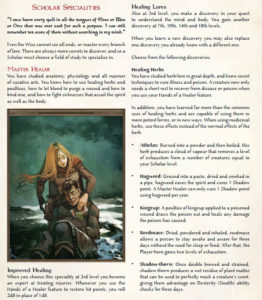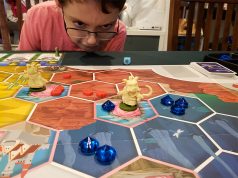I used to play roleplaying games. I’ve been a Dungeon Master for Dungeons & Dragons (Basic, Advanced, 2nd Edition, 3rd Edition), Shadowrun, d20 Modern, Pathfinder, and even a little bit of Vampire. Each system should be judged on the game mechanisms for the type of world it aims to serve and how those work with the stories expected in that world.
This is not easy. Nor is it common that a heavily themed roleplaying game does it just right. The biggest news in roleplaying that I’ve heard in a long while is not a reprint or a new edition of some roleplaying system, but rather the marriage of the D&D system with one of the origin worlds that lead to D&D in the first place.
 For the longest time, Lord of the Rings has stood on its own. Iron Crown Enterprises (ICE) released the first Middle Earth centered roleplaying game system in 1984 titled Middle-Earth Role Playing (MERP). While it was novel for its time, it didn’t generate the buzz that the Lord of the Rings Roleplaying Game did after the release of the movies of the same name. Released by Decipher, this work, ironically, still feels like D&D in another guise. The use of magic and more sandbox focused ruleset undermine the needs of an epic-fantasy story. The chapters regarding the flavor and feel of epic fantasy and shadow, core elements of Lord of the Rings, is merely a chapter with artistic directional prose, little in the way of rules.
For the longest time, Lord of the Rings has stood on its own. Iron Crown Enterprises (ICE) released the first Middle Earth centered roleplaying game system in 1984 titled Middle-Earth Role Playing (MERP). While it was novel for its time, it didn’t generate the buzz that the Lord of the Rings Roleplaying Game did after the release of the movies of the same name. Released by Decipher, this work, ironically, still feels like D&D in another guise. The use of magic and more sandbox focused ruleset undermine the needs of an epic-fantasy story. The chapters regarding the flavor and feel of epic fantasy and shadow, core elements of Lord of the Rings, is merely a chapter with artistic directional prose, little in the way of rules.
Many roleplaying gamers have thought of D&D as a combat-focused, grab-the-loot based system for churning out adventures and allowing players to create über characters that approach the powers of gods. While this is often dependent on the roleplaying group, the multiple publications of sourcebooks with new abilities and additional character powers support this preconception.
Cubicle 7, who also happens to have published the One Ring Roleplaying Game, has done something rather unexpected and also wholeheartedly welcome. Adventures in Middle-Earth brings the flavor, feel, and storytelling of the Lord of the Rings to the foundational rules system of D&D 5th Edition.
This is a big deal.
 D&D was founded to a large degree on high fantasy adventures applied to a skirmish miniatures ruleset. Re-applying a Lord of the Rings essence to the roleplaying game at this point feels almost unnecessary, until you start reading the rules modifications and adjustments to the structure of the game contained in the Player’s Guide and Loremaster’s Guide.
D&D was founded to a large degree on high fantasy adventures applied to a skirmish miniatures ruleset. Re-applying a Lord of the Rings essence to the roleplaying game at this point feels almost unnecessary, until you start reading the rules modifications and adjustments to the structure of the game contained in the Player’s Guide and Loremaster’s Guide.
Adventures in Middle-Earth (AME) is set in the Third Age of Middle Earth, just after the Battle of Five Armies and the events in The Hobbit. These years between the finding of the Ring of Power (establishing a resurgence in the Shadow) and the Fellowship of the Ring (the recognizing of the end goal) provide a perfect story foundation for player characters to advise the Council of the Wise.
To truly adopt the system, players will want to use the classes contained in the system, and they’re in for a shock. AME, for the large part, contains no player-usable magic. None of the classes have a large collection of spells. The tomes advise ways to include magic for player use, but as in the novels, magic is really the domain of mystical beings such as wizards. Low level magic is possible, but barely rises above commonplace abilities. The most interesting focus of magic occurs in legendary items the players can acquire.
The second thing to notice is that the tone and drama of Lord of the Rings is directly infused into the ruleset. When players craft characters, they develop a Background which spells out exactly how their characters respond to Hope and Despair. There are rules for the Loremaster to implement the effects of Shadow, the ever increasing evil spreading throughout Middle Earth. Combine these two elements, and you have a system focused heavily on roleplaying and character conflict without giving up completely on the heroism in combat.

Finally, one of the best things about AME is how it enforces a story structure. The authors here know that certain moments in a story are for the montage. Downtime for characters is not roleplayed. The Fellowship Phase and Journeys handle “fast-forward” moments when the minutiae of boring events are boiled down to a summary of a travel or training in town. This is perfect to move directly from the journey to Khazad-Dum to the fight at the gate with the Watcher in the Water.
Adventures in Middle Earth represents EXACTLY the kind of roleplaying game I enjoy. It’s focused tightly on story and doesn’t want or need super characters to come in a wreck a perfectly good plot. The darkness and intimacy of character is the focus. Reading through the books, you have to step back and remind yourself that this is a D&D based system, because the flavor and execution of the rules feels a world apart.
This is a roleplaying game that gets theme, story, and rules just right.






















